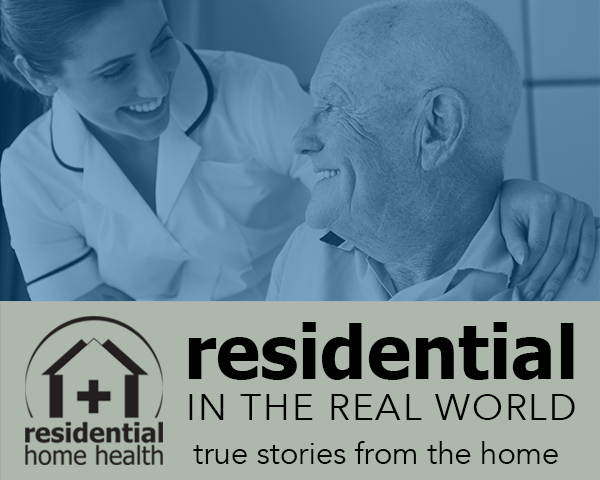Residential in the Real World
 Much of the process of monitoring health and recovery is based on comparisons. Is the patient feeling better than or worse than his or her last visit? Often, change can be a stronger indicator than condition — with only a first impression, it’s more difficult to assess what is ‘normal’ and what isn’t. Yet some circumstances require immediate action, calling for experienced and intuitive clinicians who can think on their feet.
Much of the process of monitoring health and recovery is based on comparisons. Is the patient feeling better than or worse than his or her last visit? Often, change can be a stronger indicator than condition — with only a first impression, it’s more difficult to assess what is ‘normal’ and what isn’t. Yet some circumstances require immediate action, calling for experienced and intuitive clinicians who can think on their feet.
When Residential start-of-care nurse Heather first met one new patient, she trusted the expert instinct telling her something was wrong. Read on to learn how her quick responses and definitive actions ultimately saved her patient’s life, even before his care officially began.
Intervention before Starting Care
For every Residential Home Health patient, care begins with a start-of-care visit. A clinician — frequently a specialized start-of-care nurse — works to gather a thorough health history, review medications, assess overall health and home environment, and map out the patient’s nurse and therapist care going forward. Although conducted by a licensed clinician, the start-of-care visit is generally intended to collect all the information and tools needed to map out a personalized care plan, after which the specifics of nursing and therapy can begin.
However, this intended start-of-care visit was different. Prior to Heather’s arrival, she learned, her patient had been in and out of the hospital every day for four straight days. Each time he was sent home with antibiotics, but no other diagnosis or treatment. Yet the person Heather encountered was disoriented and confined to his bed; according to his family, he had not relieved his bladder (which he did using a catheter) in days. When she spoke with the patient, he was confused and unable to remember anything from the last few days, but kept complaining about abdominal pain. Heather guessed that a full bladder was contributing to his present condition, and immediately performed a catheterization — draining an extremely large volume of fluid, and giving her patient some needed relief.
Yet although this physical symptom was relieved, Heather was distressed to see that the patient’s confusion remained — by this time, red flags were waiving. She next called the patient’s doctor, explained the symptoms she was observing, and strongly suggested that the patient be evaluated at a different hospital emergency department; the doctor agreed.
An Insightful, Fortunate Save
Within a few hours of sending her patient to a different emergency room, Heather received an emotional phone call — the patient’s daughter, in tears, was calling to thank her. As it turns out, the confusion that was troubling Heather was the result of a brain bleed, and the patient was whisked away for lifesaving cranial surgery. Without Heather’s instinctive thinking and speedy response, her patient might have died.
Instead, about a week later, Heather was able to return to her patient’s home for a proper start-of-care visit and evaluation. When she arrived, she was greeted at the door by what seemed like a totally different person. Heather’s patient — now out of bed and alert — called her ‘the nurse who saved his life,’ and the two shared an emotional hug. And with that extraordinary medical intervention behind him, the patient’s standard home care process could officially, fortunately begin.
To determine whether you or your loved one might benefit from in-home services from Residential Home Health, call (888)930-WELL (9355) to discuss your specific situation with a Home Care Specialist today, or click the image below to take our 60-second, 15-question Home Care Assessment.
{{cta(‘3073a01b-4a0b-41c6-91c0-460ecd8e3277’)}}

